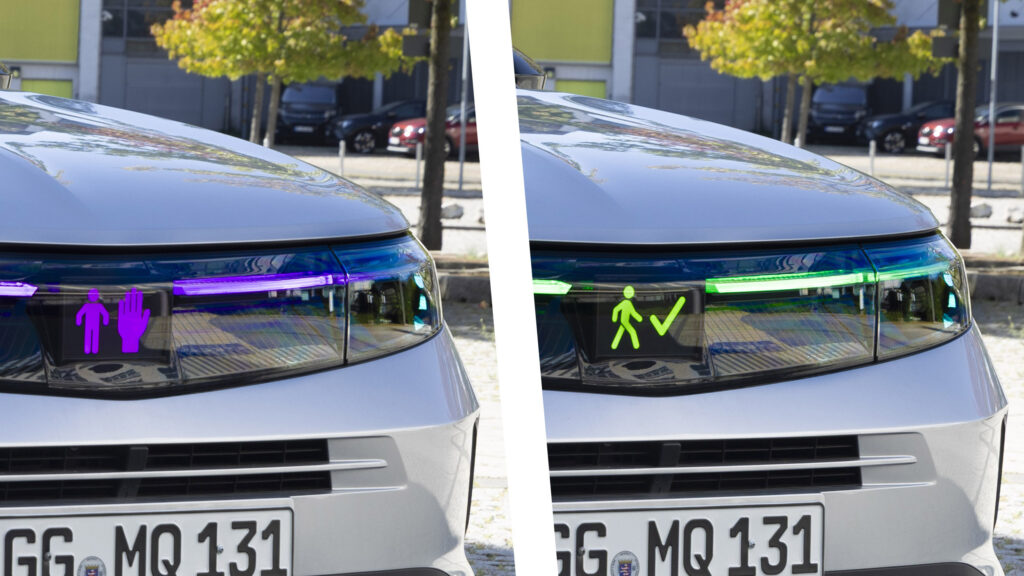Stellantis SUV Loses Its Logo To Keep Pedestrians Safe

- Semi-autonomous Opel Grandland uses colors and symbols to signal pedestrians.
- Cyan, magenta, and green replace conventional white LEDs in specific scenarios.
- Developed in-house by Opel with collaboration from TU Darmstadt University.
As cars edge closer to taking over more driving duties, the question of how they interact with the people around them becomes increasingly important. Technology may be ready to let drivers take their hands and eyes off the task, but it also raises a new challenge: how does a car signal its intentions to those outside it? In that spirit, Opel has built a Grandland prototype with a lighting system designed to speak directly to pedestrians.
More: Skoda’s Illuminated Grille Shows Pedestrians When It’s Safe To Cross The Road
The test model is equipped with Level 3 driver assistance, which allows the person behind the wheel to disengage under certain conditions. Once the vehicle is in charge, though, a fresh layer of communication is needed to make sure people on the street understand what the car is about to do.
Lights As A Language
The Grandland prototype has been fitted with a new camera system that can detect objects and gestures, combined with an AI-backed “intention prediction” function. This allows it to better recognize real world scenarios like when a pedestrian emerges from parked vehicles or a child steps on the road when chasing a ball.
When operating in Level 3 autonomy (or higher), the SUV’s front and rear indicators shine in cyan. This color was chosen as it is not associated with any other vehicle function. When a pedestrian is detected in the path of the vehicle, it starts braking and the LED headlights change from white to magenta.
Furthermore, a small screen that normally displays Opel’s Blitz emblem shows a warning sign or a pedestrian alongside a halt gesture. When the car has come to standstill, the LEDs turns green and the display shows a walking figure. In more complex situations when the AI algorithm can’t figure out what to do, the driver is prompted to take control of the vehicle.
Rethinking Headlights
Philipp Röckl, Global Lead Lighting at Stellantis, explains the thinking behind the project:
“Headlights clearly play an important part in increasing road safety – but modern lighting systems are capable of so much more. For example, lighting signatures can easily be animated and used for animations. And the illuminated Blitz on the Grandland can be substituted by a display that can both show the illuminated emblem and be used to communicate with other road users and pedestrians. By using existing lighting elements, it makes it easy to add communication features once we will introduce autonomous driving features in our cars”
The Grandland with the unique equipment and lighting features follows a number of prototypes and production vehicles from other brands that examine the same issue.
The model was created in-house in Opel’s Russelsheim headquarters in Germany and was showcased at the International Symposium on Automotive Lighting (ISAL) in Darmstadt. It is the result of a collaboration between the Opel Concept Workshop and students from the TU Darmstadt university.
More: The Stellantis Hot Hatch You’ll Never Buy But Can Still Drive At Home
Stellantis and TU Darmstadt have formed a strategic partnership for joint research into new lighting technologies since 2022. As part of this, the automaker is currently funding three doctoral students at the university’s Department of Electrical Engineering and Information Technology.
On her part, Julisa Le, Stellantis’ Lead Innovation Engineer, said:
“We specifically chose colors that are not already associated with other vehicle functions to avoid misunderstandings. For example, red is intuitively understandable, but it is already used for stop lights or the rear lights of cars. Cyan and magenta have been thoroughly evaluated for perception purposes and are currently not present in any traffic situations. Both ensure clear, unambiguous communication with other road users.”